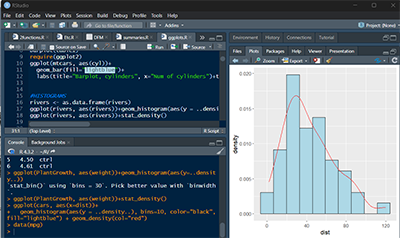STA2023: Activities
Spring 2020, Broward College
In this course the Statistical
Software R and RStudio will be used to conduct statistical
analysis.
![]()

01/07: Orientation, Introduction to the course (R, RStudio). Preview
and Statistical Thinking.
Chapter 2: Frequency Distributions, Histograms, Stem and Leaf Plots.
Download Normtemp
excel file (Data taken from the Journal of Statistics Education
online data archive. Norm temp in F for 130 individuals, dataset
includes gender and heart rate.)
Lab
1 RStudio.
01/14: Chapter 3: Measures of center, measures of
variation, measures of relative standing and boxplots. Charts that matters. Summary Chap 1, 2,3.
Practice 3. Practice3
answers in RStudio. Chapters 1, 2, 3 concepts summary pdf.
Lab
2 RStudio.
01/21. Chapter 4: intro to Probability. Basic
concepts, addition and multiplication rule. Complements and
conditional probability, counting rules, permutations, combinations,
problems involving combinations. Odds.
Lab
3 RStudio.
01/28: Review for Test 1 consists of: Review01, Review01 answers in R.
Example
of Hw question in R using Excel.
02/04. Test 1 (Chapters 1, 2, 3 & 4).
02/11: Probability distributions. Binomial
Probability distribution.
Lab 4 RStudio. Practice5. Practice5 answers in RStudio.
Additional questions: Two binomial probability experiments.
Answer
to Two Binomial experiments using R.
02/18: The standard Normal distribution.
Applications. Central Limit theorem.
Lab
5 RStudio. Practice 06. Practice 06 Ans in R.
Central Limit Theorem:
Regardless of the population distribution model, as the sample size
increases, the sample mean tends to be normally distributed around the
population mean.
T-Distribution:
The t distribution, also known as Student t-distribution, is a
probability distribution that is used to estimate population
parameters when the sample size is small and when the population
variance is unknown.
02/25: Confidence intervals or intervals estimate:
Estimating a Population proportion and a Population mean. Lab 6 RStudio.
Practice
7. Practice 7 answ in R.
03/10: Review 02. Review answers in R.
03/24: Test 2 (Chapters 5, 6 & 7).
Rare Event Rule for Inferential Statistics: if under a given assumption, the probability of a particular observed event is extremely rare, we conclude that the assumption is probably incorrect.
03/31: Hypothesis Testing. Hypothesis testing in R for
STA2023.
Lab
7 RSudio. Practice08. Practice08 Ans in R.
*Hypothesis
Testing examples to work and discuss in class.
*Worked answers to examples here with R.
Inferences about two proportions. Inferences about two means.
Notes,
comparing two groups. Independent samples, Practice 9. Practice 9 Ans in R.
TwoPropTesting.
Answers
in R.
04/07: Review3.
Review
3 Ans in R.
04/09: Test 3.
04/14: Regression and Correlation, Lab 8
RStudio.
04/21: Tests of Independence, Chi-Sq tests.
Lab
9
RStudio.
04/28: Final exam.

Mathematics
of a Lady Tasting Tea
By SIR RONALD A. FISHER
R code: > barplot(dbinom(x = 0:10, size = 10, prob = 0.5),names.arg = 0:10,space=0, main="Binomial dist histogram for n=10, p=.5")

Probability: The Deck of Cards.
A deck of cards consists of 4 suits, 13 cards each for a total of 52
cards. The four suits are: Spades, Hearts,
Diamonds, and Clubs. Each suit
contains an A (Ace), numbers from 2 to 10, and three face cards: J,
The Jack; Q, the Queen and K, the
King.
Colors: Hearts and Diamonds are red, Spades and Clubs are black.
Spades, Hearts,
Diamonds, Clubs:
![]()




